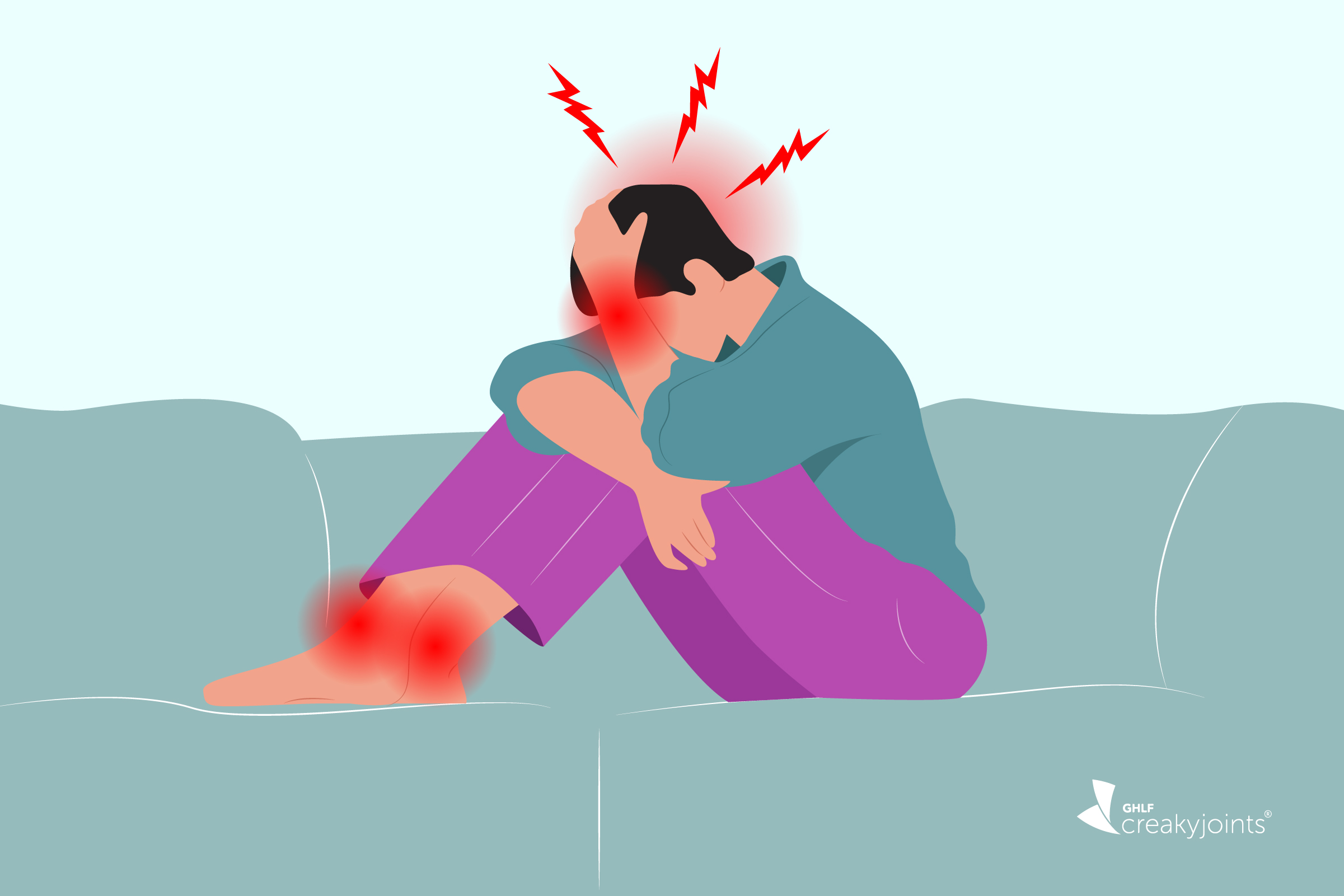Discover the symptoms of brain fog linked to migraine and learn coping strategies to manage cognitive challenges.
GOING TO THE EMERGENCY ROOM FOR MIGRAINE: HOW TO ADVOCATE FOR BETTER CARE
GOING TO THE EMERGENCY ROOM FOR MIGRAINE: HOW TO ADVOCATE FOR BETTER CARE
August 13, 2019
Jamie Sanders

No one wants to seek emergency care for a migraine attack. These tips can help ensure you get the treatment you need.
Going to the emergency room or to an urgent care center in the middle of an excruciating migraine attack is one of the last things people living with migraine want to do. Being in an extreme amount of pain along with debilitating symptoms like nausea and vomiting, photophobia, and vertigo make being in that type of environment — with their glaring lights, loud noises, and lots of hustle and bustle — very discomforting. What’s more, we migraine patients are not always treated with the empathy or compassion we desperately need during these scary moments.
But chances are you or someone you love with head pain has had to seek urgent or emergency care. According to the Migraine Research Foundation, every 10 seconds, someone in the U.S. goes to the emergency room complaining of head pain. Data from the Agency for Healthcare Research and Quality show that headaches were the first-listed diagnosis for more than 3 million emergency department visits in a single year; migraine attacks were the most common type of headache associated with people staying in the hospital.
It’s important to prepare ahead of time — when you’re not in the throes of a migraine attack —to make sure you advocate for your best migraine care in an emergency setting. There are many reasons that these environments are challenging for patients and their loved ones, which is why preparing in advance is a smart move.
- It’s hard to think clearly — hello, migraine fog — when you’re in severe pain. This can impact your ability to describe your medical history, symptoms, and current and past treatment.
- You will be meeting with new doctors who don’t know your medical history or your experience with migraine.
- Health care providers in these settings may seem dismissive of your symptoms, or worse, question your motives for seeking medication.
- The onus is on you to make sure your usual health care providers know about your emergency visit and discuss any necessary changes in your regular medication and treatment.
As someone who’s lived with migraine disease for almost 40 years, I’ve had my fair share of emergency department visits. Some have felt lifesaving; some have been completely demoralizing. I’ve compiled the tips and tools that have helped me tremendously in advocating for myself in these situations, migraine is often overlooked or completely dismissed. After implementing these strategies for better emergency department care for migraine, I’ve found that the treatment I receive from emergency department and urgent care staff to be much more pleasant and caring.
1. Know when and why to seek emergency care
Migraine attacks can happen during off hours and involve new and scary symptoms you’ve never experienced before. This is a recipe for panicking. To avoid this, talk to the provider who treats your migraine disease (your primary care doctor, neurologist, etc.) to make sure you understand their emergency protocols. They might have on-call doctors, nurses, or staff you can speak with to help triage your symptoms before you seek emergency care.
The reason most migraine patients go to urgent care or the ER is because the pain has become so severe as to be unmanageable or they are experiencing new or unusual symptoms that they worry could be something other than migraine. Your regular doctor can help you understand all the steps you can take at home to manage your migraine symptoms before you need to seek an emergency visit and know the signs that getting urgent care is critical.
2. Develop a migraine emergency treatment protocol with your doctor
Work with your regular doctor to develop a specific treatment protocol to abort a migraine that has not responded to your medications at home. How to do this:
Ask your physician to type up a brief synopsis of your history with migraine, what treatments you have tried in the past (successfully and not) and what specific medications with exact dosages you would need to abort a migraine in the ER or urgent care. Ideally this should be on letterhead and signed by your doctor.
This is your piece of armor when you go into any emergency department. It can speed up your time to receive treatment and ensure doctors don’t prescribe treatments you’ve already used and were ineffective for you.
3. Meet with your company’s human resources department to understand your benefits
During a time when you’re feeling reasonably well, schedule a meeting with the person who manages your company’s benefits to discuss those that relate to emergency care. They can walk you through your health care plan to make sure you know the costs of emergency care. Ask about other available options to offset out-of-pocket costs, such as utilizing a health or flexible spending account (HSA/FSA) to cover the costs of copays and prescriptions. It’s also smart to look into a supplemental insurance policy, such as Aflac, to cover any lost income when you need to go to the emergency room or be hospitalized. If you are not able to work due to the severity of your migraine, but your spouse or partner does, you can have a conversation about having them sign up for these options with their employer.
As well, talk to your HR department about the Family Medical Leave Act (FMLA) and when it may be appropriate for you to utilize. You may need to take time off from work for routinely scheduled doctor appointments, treatments such as medication infusions, nerve blocks, or Botox for migraine, emergency department visits or inpatient hospital stays. Having hours or days that are protected by law can help ease any anxiety or fear of adverse action by your employer.
4. Make a migraine emergency room kit
When you are having a good or semi-good day, prepare an emergency room kit that you can take with you in the event of an emergency room visit. Having all of these items in one easy-to-access place will make the process of seeking emergency care less stressful. Your kit should include your migraine binder and any of the other suggested items that bring you relief and comfort:
- A migraine binder with pertinent information that includes:
- Your treatment protocols
- List of current and past medications
- List of allergies
- List of doctors and their contact information
- A pair of sunglasses or precision-tinted glasses to block out the harsh fluorescent lighting in the waiting room.
- A pair of earplugs because the waiting areas of emergency rooms are notoriously noisy.
- If the lighting and noise level are overbearing, ask a nurse if there is a conference room you can wait in with the lights off until they are ready to call you back. It doesn’t hurt to ask, and you have a legitimate reason to.
- An icepack or cooling strip to help ease any throbbing head pain.
- You can ask the ED staff for an icepack if you do not have one.
- A bottle of water. It is important to stay as hydrated as possible while waiting to be seen. Using a reusable/refillable water bottle is probably the best option.
- Ginger candy/chews or peppermints to help calm nausea and upset stomach.
5. Bring a caregiver with you
If you can bring a partner, family member, or friend to keep you company at your emergency visit, you should. They can help provide physical comfort, support you as you share your migraine history and symptoms, take notes to help you process what happened later on, make sure your questions and concerns are addressed, and ensure you get home safely.
6. Call your regular doctor after any emergency or urgent care
Depending on your health care system, your regular doctor might not know about your visit to urgent care or the emergency department. When you’re home and after your migraine attack has subsided, follow up with your usual provider so they can adjust your medical record, be aware of any new medication you’ve received, and discuss with you whether any regular or preventive treatment changes are warranted to alleviate future migraine attacks.
Jaime Sanders has lived with migraine for most of her life. A mother of three, Sanders is a migraine patient advocate who blogs about living with chronic migraine at The Migraine Diva.
If you’re interested in becoming a migraine advocate to help improve care and medication access for people with migraine, join our 50-State Network advocacy group.
SUBSCRIBE TO GHLF
RELATED POST AND PAGES
_
Was this article helpful?
YesNo




